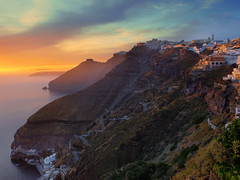interesting enough regardless.

Cliffs of Santorini's caldera, CC-BY by Flickr user hozinja.
Perhaps the most well know eruption of Santorini was the one that is thought to have ended the Minoan civilisation on Crete. Dated to around 1610 BC, this eruption was large. It released at least 30 km3 of ash and unleashed tsunamis, both of which reached Crete and would have impacted on the Minoans living there at the time. It also covered most of the Santorini with pyroclastic flows; burying the settlement of Akrotiri, which was only rediscovered in 1967. It is clearly a dangerous volcano, both to the 13,000 residents and countless tourists that visit each year and to the wider region. It is important, therefore, to piece together its history; this is the best way we have of predicting how it will behave in the future.
Firstly, why is Santorini there? Below is a map showing the Hellenic Arc, of which Santorini is part. The Ionian Trench (shown in red) is a site of subduction. The African plate is being thrust under the Aegean to the north, causing melting and volcanism.
The initial melts are basaltic, and as such are quite runny. These erupt fairly harmlessly as lava flows or fire fountains, harmless enough for some TV presenters to cook their food using them (although there are some Hawaiian residents who might feel differently about this). Larger problems arise when the magma ponds in the crust, and begins to crystallise. The remaining liquid becomes more silicic, and also more viscous. The higher viscosity makes it harder for volcanic gases to escape, allowing pressure to build up and eventually to explosive eruptions. This is exactly what happens on Santorini - most of the volcanism is intermediate (i.e. their silica content sits roughly half way between a basalt and a rhyolite) to silicic.
Take a closer look at the island of Santorini on the map above, or click here for a geological map (pdf, 5.32 MB). The most obvious feature is the huge hole in the middle of the island (actually five islands). This is the caldera; the cliffs in the photo at the top should give you some idea of the scale of this thing. Calderas are formed during large eruptions, such as Santorini's Minoan eruption. They occur when the magma chamber beneath the volcano empties enough to remove the support from the roof, leading to a collapse. At least four such eruptions have occurred on Santorini, creating the current, composite caldera.
Santorini goes through cycles of activity. For 20,000 - 40,000 years constructive volcanism dominates, with lava flows and minor explosive eruptions building up cones. The islands of Nea Kameni and Palaea Kameni are the latest example of this. They started growing after the Minoan eruption 3,600 years ago, with the most recent eruption ending in 1950. As these cones grow, progressively more and more of magma being supplied beneath the volcano gets trapped in magma chambers, and is allowed to evolve to more silicic compositions. Eventually the cycle ends with a large, explosive eruption, often destroying most of the cone that had been built up. There have been 12 such major explosive eruptions over the last 530,000 years.
Superimposed upon this is a longer-term cycle, of about 180,000 years. While most of the major eruptions are intermediate in composition, at the end of the 180,000 year cycles the magma chamber is allowed to evolve all the way to a rhyodacite (almost as silicic as a rhyolite). These are the largest, caldera forming eruptions. There were two towards the end of the first cycle, and another two recent ones: the Cape Riva (21,000 years ago) and the Minoan eruptions.
So what do I hope to achieve with my studies? I will be looking at lavas from the Therasia Dome, which used to stand in the northern half of the caldera before the Cape Riva eruption. It is now exposed in the cliffs of Therasia island (pink and marked as rt on the geological map). It is rhyodacitic, and represents the last leaks from the magma chamber before the Cape Riva caldera-forming eruption. As such, it should be possible to learn about the conditions in the magma chamber at the time. In particular, I will be looking at how fresh, mafic magma injected into the chamber mixes with the more evolved magma sitting there already. Hopefully this should give us an insight into how Santorini, and other similar volcanoes, can build up to their most dangerous eruptions.
Reference:
Druitt, T.H. et al., 1999. Santorini Volcano, London: Geological Society. Available at: http://mem.lyellcollection.org/content/vol19/issue1/.




Comments